Evaluation of the Trend of Deformation around the Kanto Region Estimated Using the Time Series of PALSAR-2 Data †
Abstract
:1. Introduction
2. Study Area and Used Data
2.1. Study Area
2.2. Used Data
3. Method
4. Results
4.1. Displacement Rates
4.2. Validation
4.2.1. Comparison with GEONET Data
4.2.2. Comparison with Levelling Data
5. Discussion
6. Conclusions
Author Contributions
Funding
Acknowledgments
Conflicts of Interest
References
- Horiguchi, Y. Outline of water-dissolved natural gas field in Chiba Prefecture. J. Jpn. Assoc. Pet. Technol. 1998, 63, 475–484. (In Japanese) [Google Scholar] [CrossRef]
- Kanto Natural Gas Development Co., Ltd. History of Lodine. Available online: http://www.gasukai.co.jp/english/iodine/index2.html (accessed on 25 June 2019).
- Chiba Prefecture. Land Subsidence in Chiba Prefecture. Available online: https://www.pref.chiba.lg.jp/suiho/jibanchinka/torikumi/genkyou.html (accessed on 25 June 2019). (In Japanese).
- Furuno, K.; Kagawa, A.; Kazaoka, O.; Kusuda, T.; Nirei, K. Ground water management based on monitoring of land subsidence and groundwater levels in the Kanto groundwater basin, central Japan. Proc. IAHS 2015, 372, 53–57. [Google Scholar] [CrossRef] [Green Version]
- Gabriel, A.; Goldstein, R.; Zebker, H. Mapping small elevation changes over large areas: Differential radar interferometry. J. Geophys. Res. 1989, 94, 9183–9191. [Google Scholar] [CrossRef]
- Massonnet, D.; Rossi, M.; Carmona, C.; Adragna, F.; Peltzer, G.; Feigl, K.; Rabaute, T. The displacement field of the Landers earthquake mapped by radar interferometry. Nature 1993, 364, 138–142. [Google Scholar] [CrossRef]
- Ferretti, A. Satellite InSAR Data—Reservoir Monitoring from Space; EAGE Publications: Houten, The Netherlands, 2014; p. 159. ISBN 978-90-73834-71-2. [Google Scholar]
- Berardino, P.; Fornaro, G.; Lanari, R.; Sansosti, E. A new algorithm for surface deformation monitoring based on small baseline differential SAR interferograms. IEEE Trans. Geosci. Remote Sens. 2002, 40, 23275–23283. [Google Scholar] [CrossRef] [Green Version]
- Ferretti, A.; Prati, C.; Rocca, F. Permanent scatterers in SAR interferometry. IEEE Trans. Geosci. Remote Sens. 2001, 39, 8–20. [Google Scholar] [CrossRef]
- Hooper, A.; Zebker, H.; Segall, P.; Kampes, B. A new method for measuring deformation on volcanoes and other natural terrains using InSAR persistent scatterers. Geophys. Res. Lett. 2004, 31, 1–5. [Google Scholar] [CrossRef]
- Ogushi, F. Monitoring of the Kanto plane in Japan with PALSAR-1 and PALSAR-2 with SBAS method. In Proceedings of the JAXA PI Meeting of Global Environment Observation Mission, Tokyo, Japan, 22–26 January 2018. [Google Scholar]
- Asaka, T.; Nonaka, T.; Hashiba, H.; Iwashita, K.; Sugimura, T. ALOS/PALSAR SBAS analysis of surface deformation in the Pacific side of Chiba prefecture, Japan. Trans. Jpn. Soc. Aeronaut. Space Sci. 2018, 16, 593–598. [Google Scholar] [CrossRef]
- Rosenqvist, A.; Shimada, M.; Suzuki, S.; Ogushi, F.; Tadono, T.; Watanabe, M.; Tsuzuku, K.; Watanabe, T.; Kamijyo, S.; Aoki, E. Operational performance of the ALOS global systematic acquisition strategy and observation plans for ALOS-2 PALSAR-2. Remote Sens. Environ. 2014, 155, 3–12. [Google Scholar] [CrossRef]
- Japan Aerospace Exploration Agency. ALOS-2 Project. Available online: https://www.eorc.jaxa.jp/ALOS/en/top/about_top.htm (accessed on 22 July 2019).
- Nonaka, T.; Asaka, T.; Iwashita, K.; Ogushi, F. Estimation of phase noise by time series analysis of ALOS-2 PALSAR-2 data. In Proceedings of the IGARSS2017 International Geoscience and Remote Sensing Symposium, Fort Worth, TX, USA, 23–28 July 2017. [Google Scholar]
- Asaka, T.; Nonaka, T.; Uchida, Y.; Sugimura, T. Evaluation of reinforced slope dynamics using ALOS-2/PALSAR-2. In Proceedings of the IGARSS2019 International Geoscience and Remote Sensing Symposium, Yokohama, Japan, 29 July–2 August 2019. [Google Scholar]
- Chiba Prefecture. Monthly Residents Survey Statics. Available online: https://www.pref.chiba.lg.jp/toukei/toukeidata/joujuu/geppou/2019/index.html (accessed on 22 July 2019). (In Japanese).
- Geospatial Information Authority of Japan, Service to Provide GEONET Data. Available online: https://terras.gsi.go.jp/ (accessed on 25 June 2019).
- Chiba Prefecture. Chiba Prefecture Levelling Survey Results. Available online: https://www.pref.chiba.lg.jp/suiho/jibanchinka/torikumi/seikaomote.html (accessed on 25 June 2019). (In Japanese).
- Tanno, Y.; Maruyama, M.; Kannno, R. Location of gas-chemical and metal machinery industries and their business change in Kujukuri area Chiba Prefecture. Ann. Hum. Reg. Geogr. 2006, 28, 101–126. (In Japanese) [Google Scholar]
- SARMap SBAS Tutorial. Available online: http://sarmap.ch/tutorials/sbas_tutorial_V_2_0.pdf (accessed on 25 June 2019).
- Pasquali, P.; Cantone, A.; Riccardi, P.; Defilippi, M.; Ogushi, F.; Gagliano, S.; Tamura, M. Mapping of Ground Deformations with Interferometric Stacking Techniques. In Land Application of Radar Remote Sensing; Holecz, F., Pasquali, P., Milisavljevic, N., Closson, D., Eds.; IntechOpen: London, UK, 2014; Available online: https://www.intechopen.com/books/land-applications-of-radar-remote-sensing/mapping-of-ground-deformations-with-interferometric-stacking-techniques (accessed on 25 June 2019). [CrossRef] [Green Version]
- Jarvis, A.; Reuter, H.; Nelson, A.; Guevara, E. Hole-filled SRTM for the Globe Version 4, Available from the CGIAR-CSI SRTM 90m Database. Available online: http://srtm.csi.cgiar.org (accessed on 25 June 2019).
- Goldstein, R.; Werner, C. Radar interferogram filtering for geophysical applications. Geophys. Res. Lett. 1998, 25, 4035–4038. [Google Scholar] [CrossRef] [Green Version]
- Costantini, M. A novel phase unwrapping method based on network programming. IEEE Trans. Geosci. Remote Sens. 1998, 36, 813–821. [Google Scholar] [CrossRef]
- Nonaka, T.; Asaka, T.; Iwashita, K.; Ogushi, F. Analysis of the trend of the deformation around Kanto region estimated by the time series of PALSAR-2 data. In Proceedings of the Geoinformation for Disaster Management 2019, Prague, Czech Republic, 3–6 September 2019. [Google Scholar]
- Aimaiti, Y.; Yamazaki, F.; Liu, W. Multi-sensor InSAR analysis of progressive land subsidence over coastal city of Urayasu, Japan. Remote Sens. 2018, 10, 1304. [Google Scholar] [CrossRef] [Green Version]
- Lu, Y.; Ke, C.; Zhou, X.; Wang, M.; Lin, H.; Chen, D.; Jiang, H. Monitoring land deformation in Changzhou city (China) with multi-band InSAR data sets from 2006 to 2012. Int. J. Remote Sens. 2018, 39, 1151–1174. [Google Scholar] [CrossRef]
- Hansen, R. Radar Interferometry: Data Interpretation and Error Analysis; Springer Netherlands: Dordrecht, The Netherlands, 2001; p. 308. ISBN 978-90-481-5696-2. [Google Scholar]
- Zebker, H.; Villasenor, J. Decorrelation in interferometric radar echoes. IEEE Trans. Geosci. Remote Sens. 1992, 30, 950–959. [Google Scholar] [CrossRef] [Green Version]
- Motooka, T.; Isoguchi, O.; Sakashita, M.; Shimada, M. Results of ALOS-2 PALSAR-2 calibration and validation after 3 years of operation. In Proceedings of the IGARSS2018 International Geoscience and Remote Sensing Symposium, Valencia, Spain, 22–27 July 2018. [Google Scholar]
- Nonaka, T.; Asaka, T.; Iwashita, K. Evaluation of atmospheric effects on interferograms using DEM errors of fixed ground points. Sensors 2018, 18, 2336. [Google Scholar] [CrossRef] [PubMed] [Green Version]
- Nonaka, T.; Asaka, T.; Iwashita, K. Feature of DEM produced by Interferometric technique by ALOS PALSAR data. In Proceedings of the 60th (2016 Spring) Meeting of the Remote Sensing Society of Japan, Chiba, Japan, 12–13 May 2016. (In Japanese). [Google Scholar]
- Casu, F.; Manzo, M.; Lanari, R. A quantitative assessment of SBAS algorithm performance for surface deformation retrieval from DInSAR data. Remote Sens. Environ. 2006, 102, 195–210. [Google Scholar] [CrossRef]
- Pepe, A.; Bonano, M.; Zhao, Q.; Yang, T.; Wang, H. The use of C-/X-band time-gapped SAR data and geotechnical models for the study of Shanghai’s ocean-reclaimed lands through the SBAS-DInSAR technique. Remote Sens. 2016, 8, 911. [Google Scholar] [CrossRef] [Green Version]
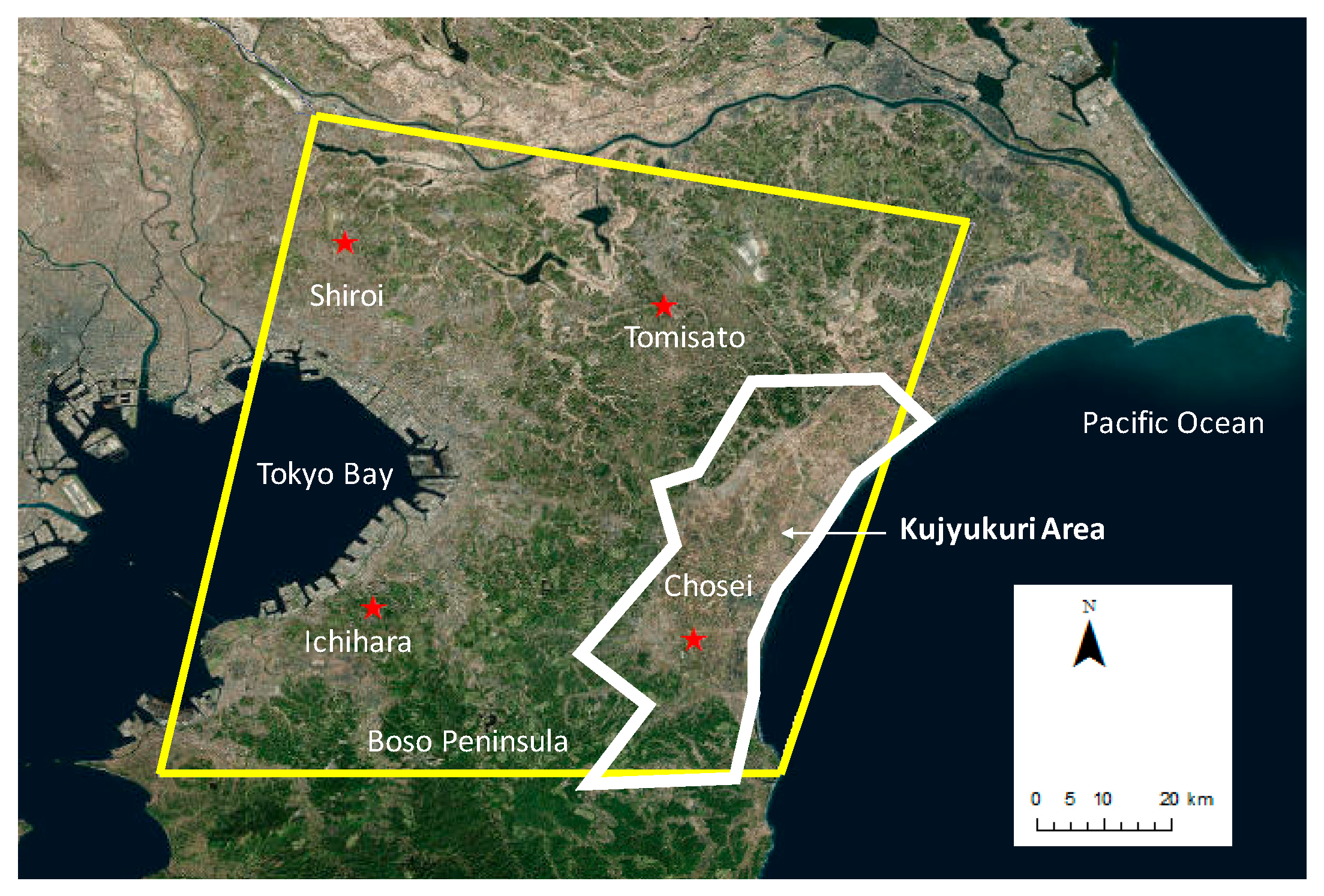
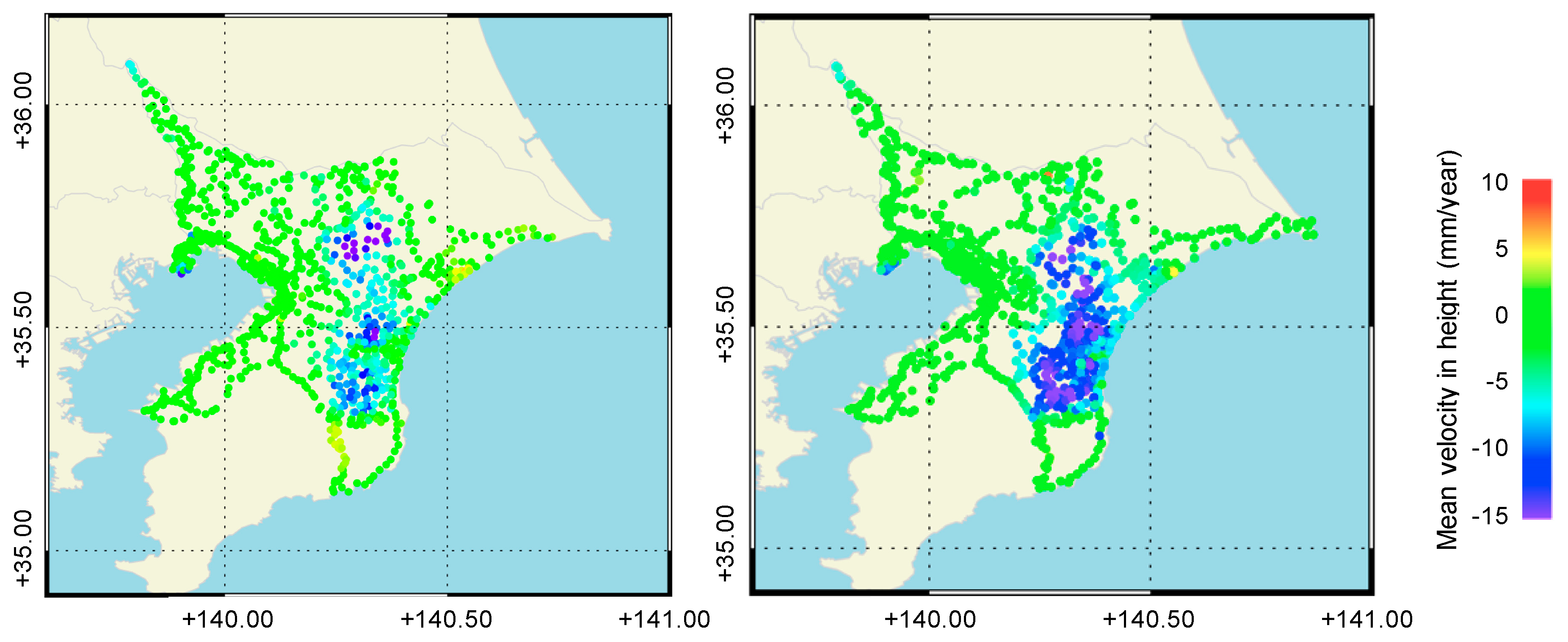


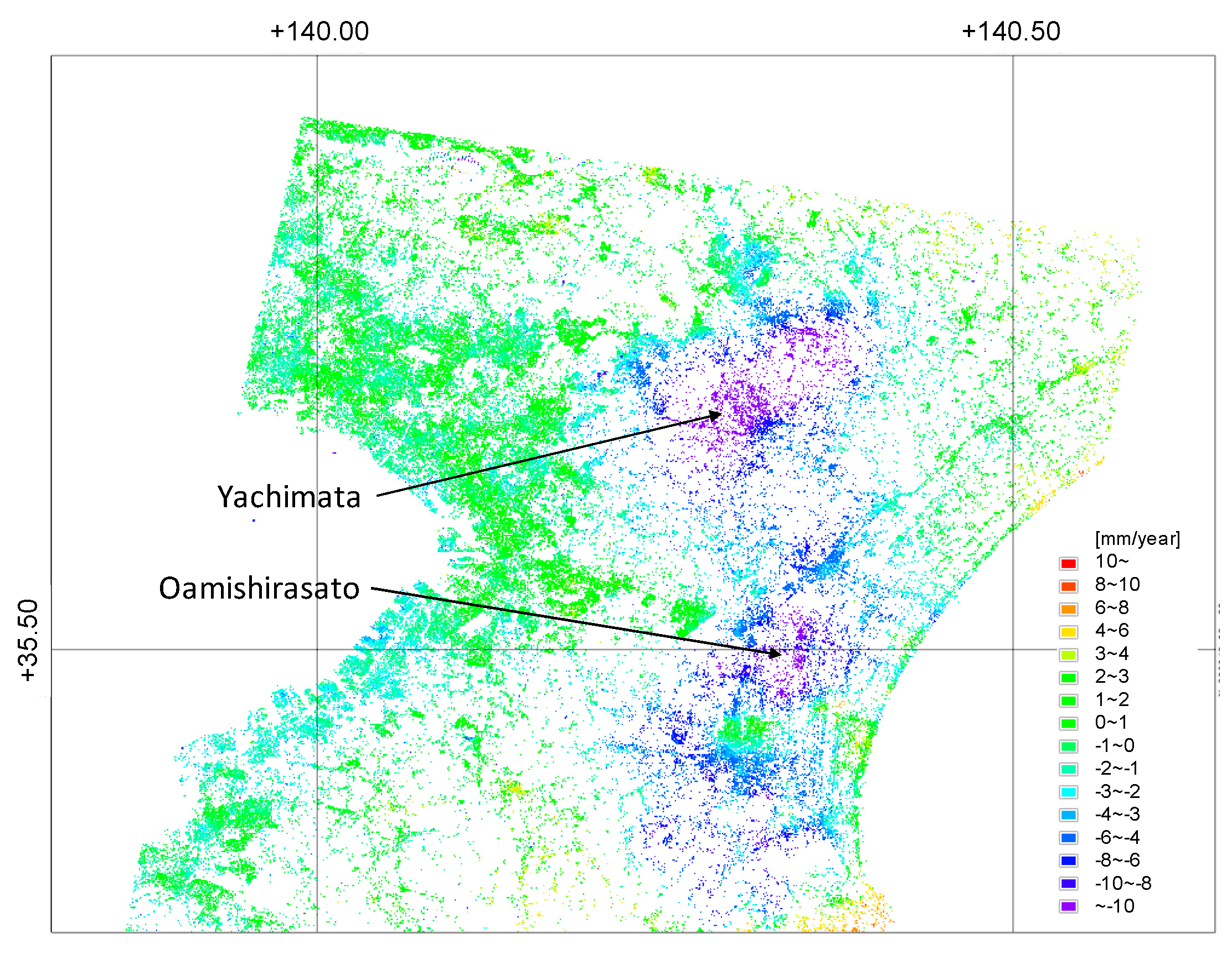
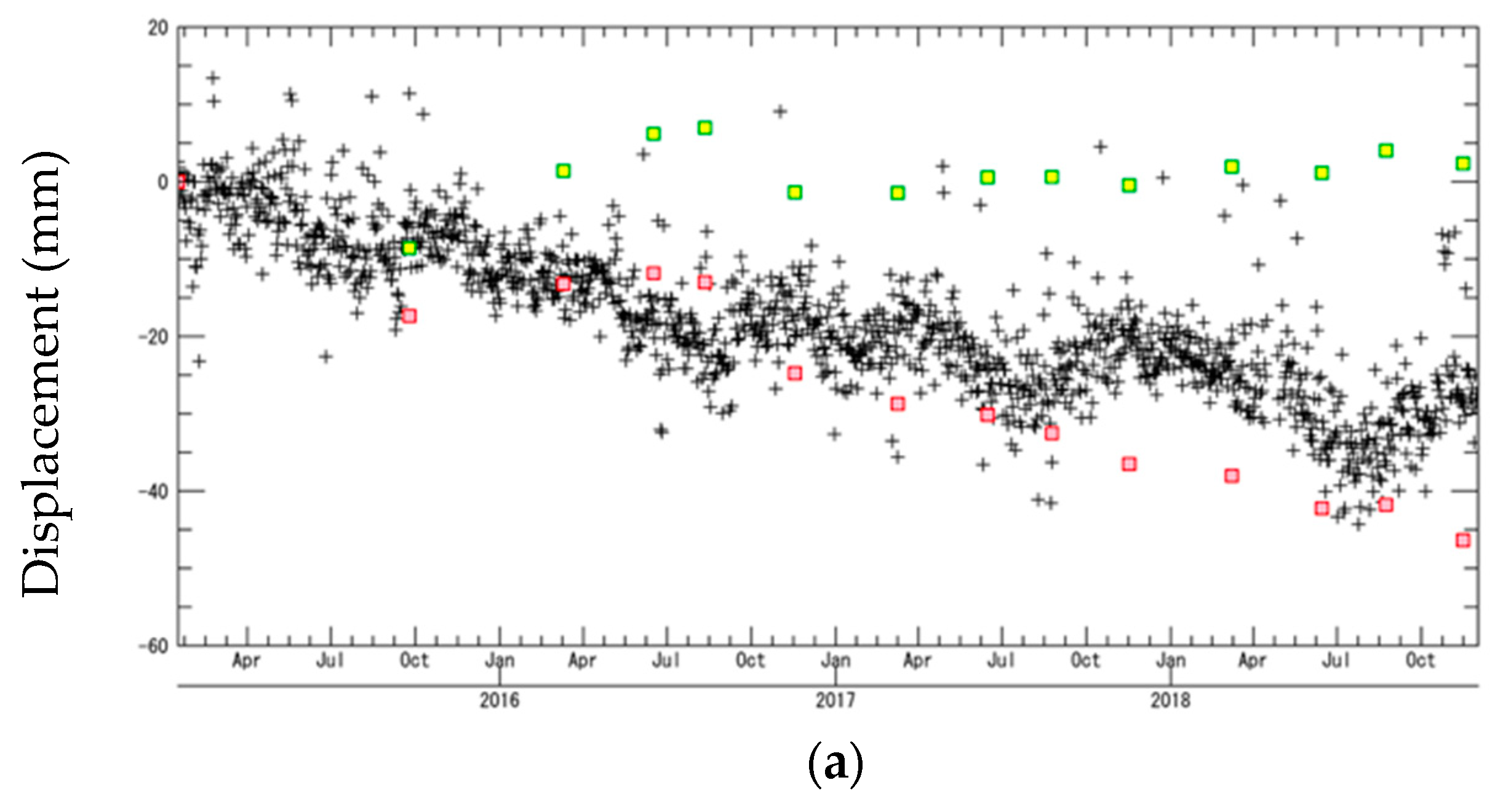

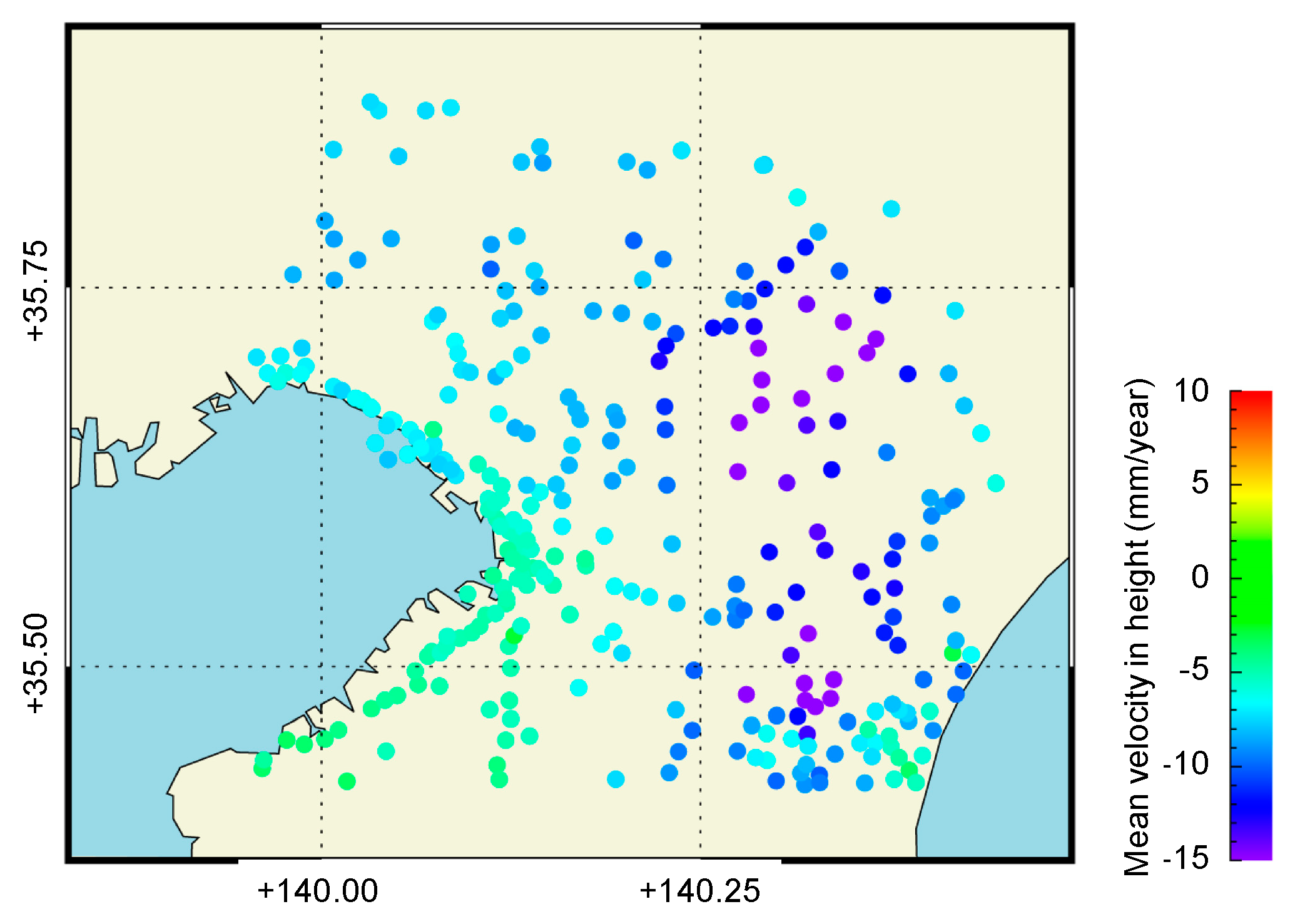

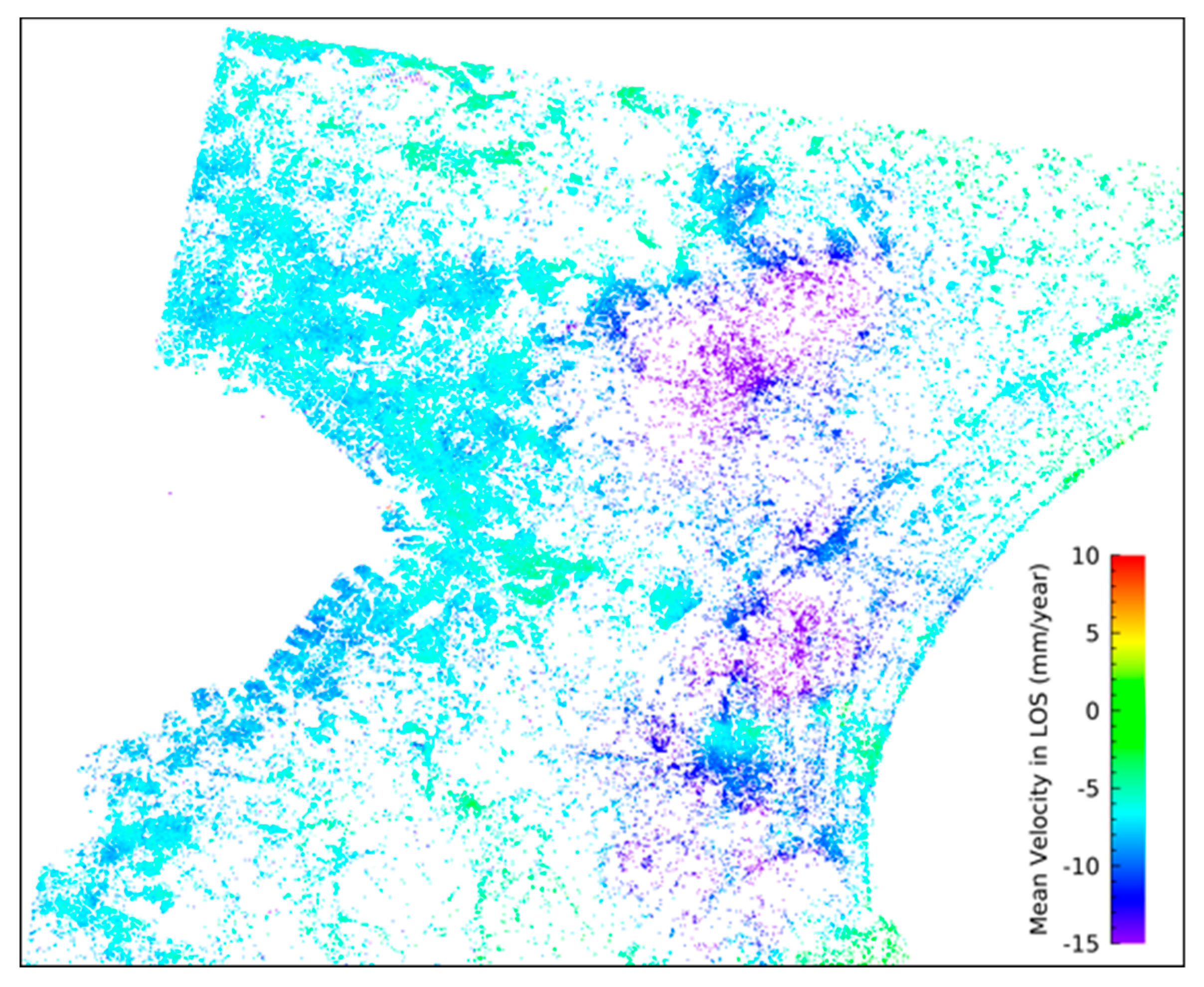
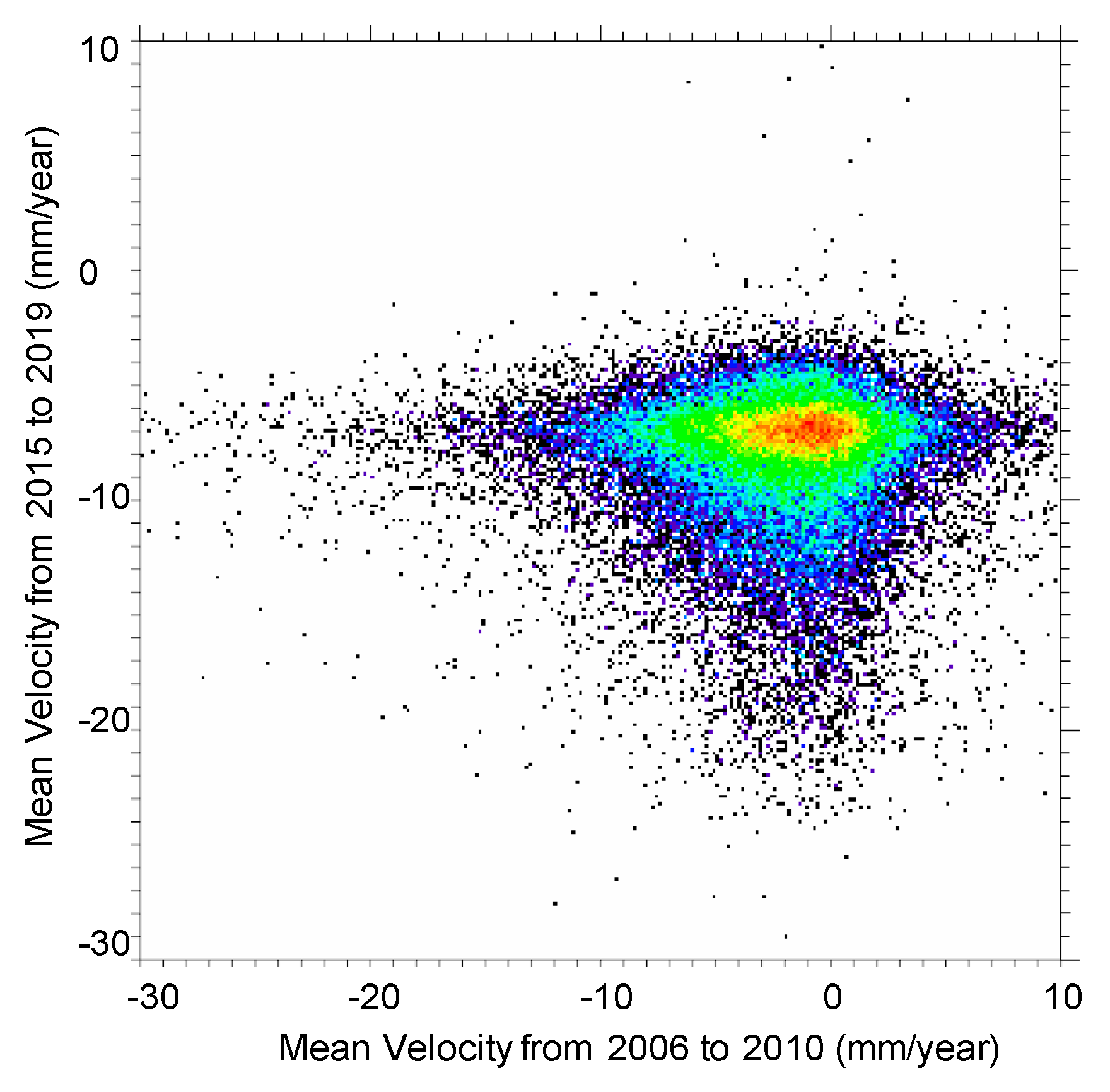
| Band (wavelength) | L-band (24 cm) |
| Operation mode | Ultrafine |
| Polarization | HH |
| Resolution | 3 m |
| Swathe | 50 km |
| Off-nadir angle | 32.8° |
| Orbit direction | Descending |
| Revisit cycle | 14 days |
| No | Acquisition Date |
|---|---|
| 1 | 15 January 2015 |
| 2 | 24 September 2015 |
| 3 | 10 March 2016 |
| 4 | 16 June 2016 |
| 5 | 11 August 2016 |
| 6 | 17 November 2016 |
| 7 | 9 March 2017 |
| 8 | 15 June 2017 |
| 9 | 24 August 2017 |
| 10 | 16 November 2017 |
| 11 | 8 March 2018 |
| 12 | 14 June 2018 |
| 13 | 23 August 2018 |
| 14 | 15 November 2018 |
| 15 | 7 March 2019 |
| Corrected PALSAR-2 | Original PALSAR-2 | PALSAR | |
|---|---|---|---|
| Time | 2015–2019 | 2006–2010 | |
| Number of points | 310 | 519 | |
| RMSE of the mean velocity | 2.0 mm/year | 6.8 mm/year | 3.5 mm/year |
| Linear regression slope | 1.00 | 0.89 | 0.96 |
| Linear regression intercept | −0.03 | −6.69 | −1.44 |
| Correlation coefficients | 0.82 | 0.70 | |
© 2020 by the authors. Licensee MDPI, Basel, Switzerland. This article is an open access article distributed under the terms and conditions of the Creative Commons Attribution (CC BY) license (http://creativecommons.org/licenses/by/4.0/).
Share and Cite
Nonaka, T.; Asaka, T.; Iwashita, K.; Ogushi, F. Evaluation of the Trend of Deformation around the Kanto Region Estimated Using the Time Series of PALSAR-2 Data. Sensors 2020, 20, 339. https://doi.org/10.3390/s20020339
Nonaka T, Asaka T, Iwashita K, Ogushi F. Evaluation of the Trend of Deformation around the Kanto Region Estimated Using the Time Series of PALSAR-2 Data. Sensors. 2020; 20(2):339. https://doi.org/10.3390/s20020339
Chicago/Turabian StyleNonaka, Takashi, Tomohito Asaka, Keishi Iwashita, and Fumitaka Ogushi. 2020. "Evaluation of the Trend of Deformation around the Kanto Region Estimated Using the Time Series of PALSAR-2 Data" Sensors 20, no. 2: 339. https://doi.org/10.3390/s20020339
APA StyleNonaka, T., Asaka, T., Iwashita, K., & Ogushi, F. (2020). Evaluation of the Trend of Deformation around the Kanto Region Estimated Using the Time Series of PALSAR-2 Data. Sensors, 20(2), 339. https://doi.org/10.3390/s20020339





